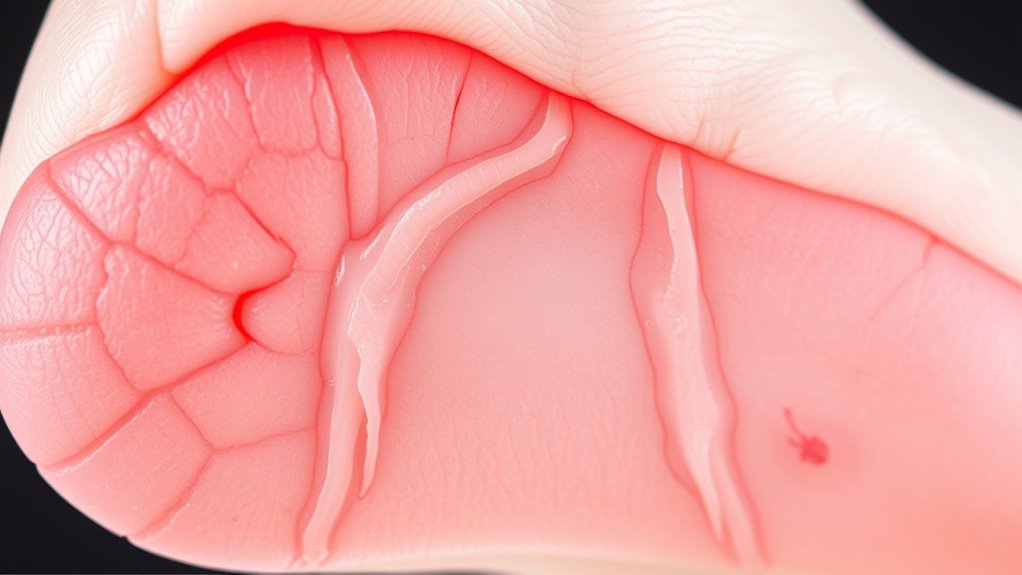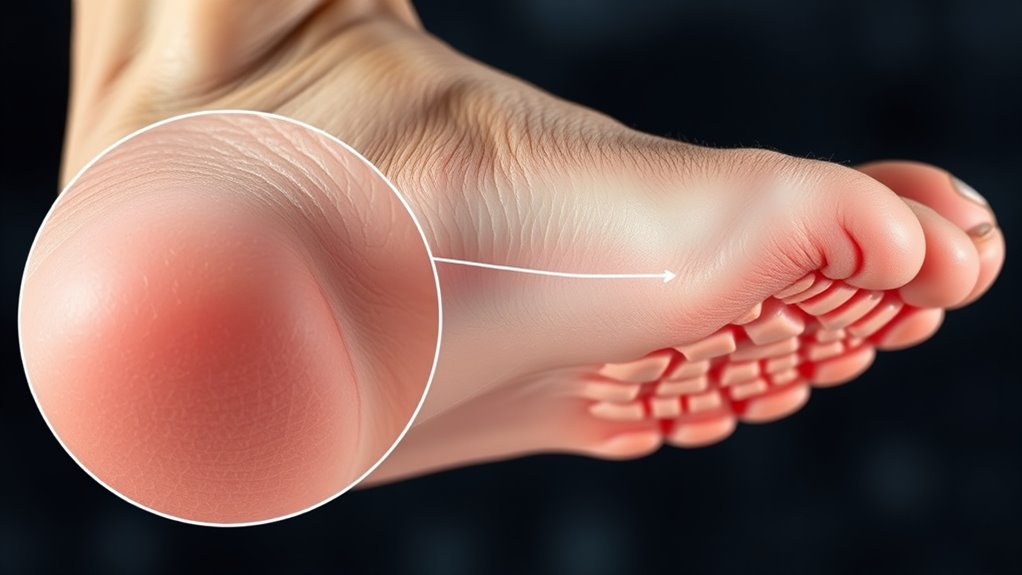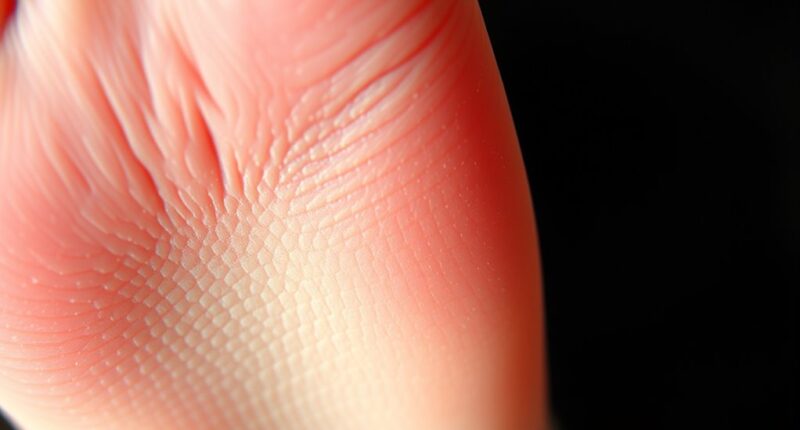Understanding foot‑strike patterns reveals how each style affects your running efficiency, injury risk, and shoe wear. Heel strikes absorb impact over a larger area but can increase knee stress, while midfoot strikes promote better shock absorption and balance. Forefoot striking offers quick propulsion but wears shoes faster and may cause stress injuries. Choosing the right pattern depends on your goals and biomechanics. Explaining these differences more deeply helps you decide what’s best for your running approach.
Key Takeaways
- Foot‑strike patterns include heel, midfoot, and forefoot, each affecting shock absorption and running biomechanics differently.
- Heel striking involves initial ground contact on the heel, often resulting in larger impact forces and potential knee stress.
- Midfoot strikes promote balanced shock absorption and natural gait, reducing joint stress and improving efficiency.
- Forefoot striking concentrates impact on the ball of the foot, enabling quick propulsion but increasing shoe wear.
- Technological tools like gait analysis and biomechanics research help identify optimal strike patterns for performance and injury prevention.
Understanding the Biomechanics of Foot‑Strike Patterns

Understanding the biomechanics of foot‑strike patterns is essential for grasping how your foot interacts with the ground during running. Your ankle mobility plays a vital role, allowing your foot to adapt to different surfaces and strike types. For instance, a flexible ankle can help absorb shock and facilitate a smooth shift from heel to toe. Shoe cushioning also influences your biomechanics by impacting how force is transmitted and absorbed. Cushioned shoes can reduce impact on heel strikes, encouraging a midfoot or forefoot strike. Recognizing how ankle mobility and shoe cushioning affect your foot’s interaction with the ground helps you better understand your running style and potential injury risks. Additionally, advancements in robotics and automation are increasingly transforming sports training and injury prevention by providing precise biomechanical analysis. Incorporating real-time gait analysis technologies can further optimize your running technique and reduce injury likelihood. Understanding foot‑strike biomechanics can also guide you in selecting appropriate footwear and training strategies to improve performance and decrease injury risk. This foundational knowledge guides you in choosing the right footwear and adjusting your technique for peak performance.
Comparing the Pros and Cons of Each Style

Each foot‑strike style offers distinct advantages and challenges that can particularly impact your running experience. Heel strikers often enjoy increased shoe durability because their impact is absorbed over a larger area, but they may face higher injury risks like knee pain due to braking forces. Midfoot strikes promote better shock absorption and can reduce stress on joints, contributing to injury prevention, while shoes tend to wear evenly. Shoes designed for midfoot striking often provide a more natural foot biomechanics, which can enhance overall running efficiency. Additionally, midfoot striking encourages a balanced gait, reducing the likelihood of overuse injuries. Shoes optimized for midfoot striking typically support a neutral foot position, further promoting proper alignment. Forefoot strikers often benefit from quicker propulsion and may experience fewer repetitive stress injuries, but their shoes might wear out faster due to concentrated pressure points. Each style influences how your shoes perform and wear, affecting durability and injury risk. Understanding the impact forces associated with each style can help you choose footwear that best supports your running needs. Choosing the right style hinges on understanding these trade-offs to optimize comfort, longevity, and safety.
Finding the Right Foot‑Strike for Your Running Goals

Choosing the right foot‑strike pattern depends largely on your running goals, whether you’re aiming for speed, endurance, or injury prevention. To find your ideal style, consider shoe compatibility—some shoes are designed for heel strikes, while others support mid or forefoot striking. Proper footwear can enhance your running efficiency and reduce injury risk. If injury prevention is your priority, a softer midfoot or forefoot strike might lessen impact forces compared to heel striking. Conversely, if you’re focused on speed and longer distances, heel strikes with appropriate shoes can offer stability. It is also important to stay informed about foot‑strike research and how different patterns affect your biomechanics. Ultimately, experimenting with different foot‑strike patterns while ensuring your shoes support your chosen style can help you achieve your goals safely and effectively.
Frequently Asked Questions
How Can I Identify My Natural Foot‑Strike Pattern?
To identify your natural foot‑strike pattern, start with a gait analysis, ideally done by a professional or through a detailed video review. Observe how your foot lands during running or walking. You can then consider footwear modifications, like shoes designed for your specific pattern. Paying attention to how your heel, midfoot, or forefoot contacts the ground will help you determine your natural strike, guiding better footwear choices and injury prevention.
Do Different Terrains Influence Foot‑Strike Style?
Different terrains definitely influence your foot‑strike style. You instinctively adapt to surface impact and terrain variation, shifting your strike for better stability and comfort. For example, on uneven or softer surfaces, you might land more midfoot or forefoot to improve terrain adaptation and reduce impact. So, your running style naturally adjusts to optimize surface impact management, helping you stay balanced and injury-free across diverse running environments.
Can Switching Foot‑Strike Patterns Improve Running Performance?
Did you know switching your foot‑strike pattern can enhance running economy? When you adapt your training, changing from heel to forefoot strike, it can lead to better energy efficiency and performance. This training adaptation may reduce impact forces, helping prevent injuries. While it might take time to adjust, many runners find that a strategic change in foot‑strike improves their overall running performance and endurance.
Are There Injury Risks Associated With Changing Foot‑Strike Patterns?
Changing your foot‑strike pattern can influence injury risks, especially if you don’t allow your body to adapt properly. You might experience overuse injuries if your biomechanics aren’t aligned, or if you rush the shift. Biomechanical adaptations take time, so gradually adjusting your gait helps prevent strain and reduces injury risk. Listen to your body and consider seeking guidance to make safe, effective changes to your running form.
How Do Minimalist Shoes Affect Foot‑Strike Techniques?
Did you know that 70% of runners report improved comfort with minimalist footwear? Wearing minimalist shoes encourages natural biomechanics, often leading to a shift towards forefoot or midfoot strikes. This change can reduce impact forces on your joints. By embracing minimalist footwear, you may enhance your running efficiency and decrease injury risk, as it promotes a more natural, biomechanical movement pattern.
Conclusion
Choosing your foot‑strike pattern is like picking the right key to unlock your running potential. Whether you land heel, mid, or forefoot, each has its own rhythm and story. Find the one that resonates with your goals and feels natural, and you’re set to dance through your runs with confidence. Remember, your feet are the compass; listen to their signal, and let your stride lead you to your best run yet.









